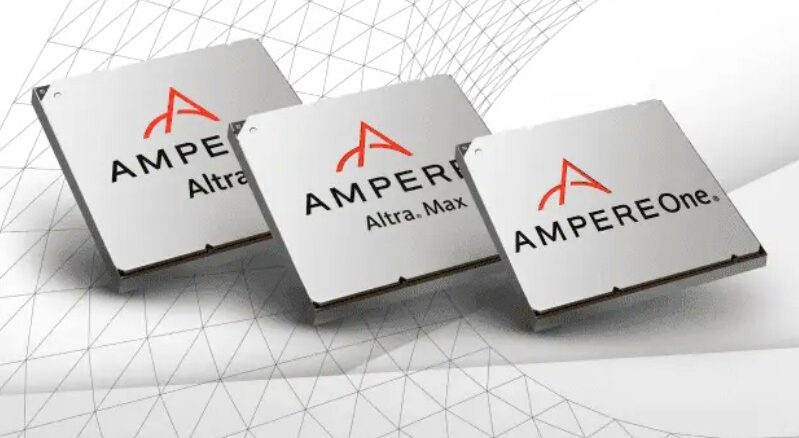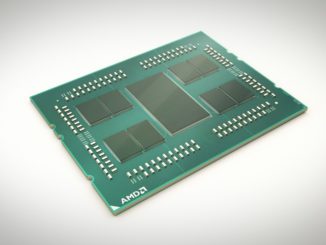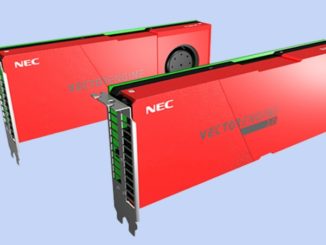
The world is getting stranger, isn’t it? We understand, given the difficulties of selling Arm server chips to hyperscalers and cloud builders that are also designing and manufacturing their own Arm CPUs, why Ampere Computing, the only successful freestanding Arm server CPU supplier to even get its chips into its chosen tech titan customers, would want to be acquired by Japanese conglomerate SoftBank.
Or, more precisely, we understand why Ampere Computing’s big investors, which include Oracle and Carlyle Group, would want to cash out. But the only reason why we can think that Softbank would want to acquire Ampere Computing for $6.5 billion is to get the 1,500 people or so that are chip and microcode engineers who have brought to market three generations of Arm server chips so that they might be deployed to help OpenAI bring a homegrown AI accelerator to market.
And as an added bonus, any new approaches and features that Ampere Computing has done in creating its custom Arm cores could be sold to Arm Ltd, the creator and licensee of the Arm architecture that went public back in September 2024. But SoftBank, which had owned Arm since paying $32.4 billion for it back in July 2016, still owns 90 percent of the chip component designer and did not really need Ampere Computing to have the intellectual property to make a CPU for the Stargate Project headed up by OpenAI, which seeks to spend $500 billion over the next four years to build out AI infrastructure for the AI model maker.
Under the Stargate deal, announced back in January with President Trump at the White House, OpenAI has “operational responsibility” for Stargate and SoftBank has “financial responsibility” for the project. That does not mean SoftBank is ponying up that money, and in fact, we think very little of the money allocated for Stargate is coming from SoftBank and even less is coming from OpenAI, and that most of it is coming from MGX, one of the many investment arms of the United Arab Emirates, which has $1.4 trillion to invest outside of the indigenous oil business that has made the country rich.
SoftBank already owns Arm, which could easily make a server CPU chip for OpenAI to use as a host for its AI systems. SoftBank already owns AI accelerator and system maker Graphcore, which it bought in July 2024. Buying Ampere Computing would seem to be redundant, despite the fact that the company, founded by server chip experts from Intel, Applied Micro, and others, has a roadmap to get to 512-cores in a socket and to add local AI processing in the CPU package with its “Aurora” AmpereOne A3 processor, expected sometime next year.
We do not think that SoftBank, working at the behest of OpenAI through the Stargate Project, is going to just take an Ampere Aurora A3 processor and marry it to one or more of its third generation “Bow” Intelligence Processing Units, or IPUs, which is another name for an AI tensor math unit. But we do think that probably somewhere around 1,500 of the nearly 2,000 people at Ampere Computing are chip designers and that these people, plus those working at Graphcore, could be tapped by OpenAI to help design custom CPUs and GPUs for the Stargate effort.
This is just a guess, of course. Why else would SoftBank pay $6.5 billion for a company that is hoping to be a second source processor for the hyperscalers and cloud builders who are all making their own Arm server CPUs and who also buy scads of X86 server processors from Intel and AMD? As far as we know, Sam Altman & Co has not put together a chip development team of any appreciable size, and even if it had, OpenAI has not created a compute engine and shepherded it through development.
Ampere Computing, on the other hand, has the “Quicksilver” Altra, the “Mystique” Altra Max, and the “Siryn” AmpereOne M out the door, with the “Polaris” AmpereOne MX scheduled to ship at the end of last year and the “Magnetrix” AmpereOne M2 in fabrication. The earlier Altra and Altra Max CPUs were bought by Oracle, Google, Microsoft, Tencent, Alibaba, and Baidu, but everyone but Oracle is now working on or has delivered their own Arm CPUs or, in the case of Alibaba, an Arm CPU and a RISC-V CPU. Oracle has a 29 percent stake in Ampere Computing, which was rumored to be angling to go public back in April 2022 and by April 2023 it was reportedly shelved.
Oracle is also a cloud hosting partner of OpenAI for Stargate, although neocloud CoreWeave was brought into the Stargate fold last week. So Oracle doesn’t own all of that OpenAI hosting business.
The upstart chipmaker apparently raised somewhere in the neighborhood of $340 million in several rounds of funding, and had reached a peak $8 billion in valuation about the time SoftBank was said to be mulling over an investment back in early 2022. Including its investments in processors and into the company, Oracle has reportedly put $1.5 billion into Ampere Computing over the years, and now it will be getting just shy of $1.9 billion back in the all-cash acquisition by SoftBank. It is not clear how much dough Carlyle Group will get or what its current stake is, or what other investors will receive.
Ampere Computing is going to be operated as a separate entity and not folding into Arm Ltd, which would confuse the hell out of Arm’s datacenter chip licensing customers. But that is not to say that Ampere Computing could not license its custom cores to Arm for others to use, or that parts of the Ampere Computing team could not end up working for Arm. Or for what remains of Graphcore, for that matter. It also seems likely that OpenAI, through Stargate, will be a big customer of the future 512-core Aurora chip for its AI systems, if it indeed moves away from using Nvidia iron. The first iron that Stargate is buying, and that is being installed in Stargate datacenters in Texas, are based on Nvidia technology.
The acquisition of Ampere Computing by SoftBank is expected to close in the second half of this year. It is hard to imagine what regulators might use as a reason to block the deal.





The first question you should be asking is “what happens when you compete against your customers?”. SoftBank wants to go into the silicon business. If ARM starts selling silicon, it won’t confuse their licensees, it will p*ss them off. Although some of ARM’s licensees have their toe in that water, there are no high end RISCV CPUs (yet) developed. ARM selling its own silicon would have its licensees shove that toe in the water and jump into the RISCV pool completely. I can’t imagine how they would feel if they spend a couple hundred million $ developing an enterprise chip only to find out ARM has developed one with an architectural feature “they just added”. Secondly, ARM does not have chip manufacturing expertise. They develop a subsystem on the silicon albeit an important one but do not do the full integration, manufacture and test expertise for end silicon. They could grow into it but why not buy it if TTM is of the essence. As always, TTM in the silicon world is always of the essence.
Yes! The $500B 5-GW “death”-star-gate AI project is major motivation … straight-quoting Masayoshi: “The future of Artificial Super Intelligence requires […] Ampere’s expertise [that] will help accelerate this vision, and deepens our commitment to AI innovation in the United States” ( https://group.softbank/en/news/press/20250320 ).
But not only!
Right next to the Galactic Empire’s DeathStar AI, and in order to hedge bets against potential uprisings by Rebel Alliances, there also stands the unique mystic river witchcraft powers of Cristal Ball Intelligence AI, aimed spherically at transforming businesses in Japan itself ( https://www.softbank.jp/en/sbnews/entry/20250207_01 ). Its exceptional ARM of agentic empowerment will wrestle through Poseidon’s temple of Kleidi libraries, like a medal-winning champ, to provide the most power-efficient of Cheeky Olympian compute ( https://newsroom.arm.com/blog/arm-cristal-intelligence ).
It is this outstanding combination of DeathStar and Crystal Ball, that makes the Ampere AI acquisition such a truly psychic force, of the may-it-be-with-you persuasion, IMHO! 8^b
This comment comes from a lower gastric-intestinal location, but my Spidey sense ( sorry mixing metaphors ) tells me that SoftBank, as an entity that seems to be hell bent on chasing dreams and memes in the computing and tech world, saw Ampere as both a way to further burrow into the AI Hallucinatory Universe and to have another platform from which to extract rent, much in the same way Arm’s licensing scheme goes.
Correct me if I’m wrong, but who else in non-X86 land is remotely competitive in the HPC / AI space other than Arm, in general, and Nvidia and Ampere specifically. I know Qualcomm continues to try to break into this space but they’re still mostly Edge and Mobile at least to the best of my limited knowledge on such things.
So this deal kinda, maybe, sorta makes sense from the standpoint of SoftBank wanting to have a prestige Arm based offering that might appeal to a big client or clients plural who…
A: Don’t want to go x86 for their project
B: Don’t want to genuflect all their money to Jensen Huang
C: Don’t want to roll their own Arm based solution as the Hyperscalers do
That’s a pretty narrow niche. However, a tidy profit can be found in the right niche. So, if that can be found, a client with that need might look at Ampere more favorably now that it is owned by SoftBank than as a struggling, independent company. And that means SoftBank has another income stream they did not have otherwise. Plus…Ampere, as a developer for and user of Arm IP, that only helps SoftBank support their other company Arm. I will use the hand scratching backs metaphor rather than one that involves a circle….because that’s NSFW.
Stargate seems very suspicious in it’s entirety.
You know….I have a bad feeling about this now. SoftBank is a big bankroller in OpenAI but doesn’t have nearly the cash to make a significant dent in OpenAI’s Statgate funding needs. SoftBank just now bought Ampere. And SoftBank is a big investor in Coreweave whose IPO is today March 28th and Coreweave’s only real customer is OpenAI who is in trouble
( running out of GPUs, ChatGPT 4.5 hallucinates nearly 40% of the time, burning through cash like a Solar Flair ). Plus Coreweave’s IPO got priced to $40 dollars per share down from $55 per share and that’s before market open.
Coupled this with the updated news that Microsoft has pulled back from 2 gigawatts of Datacenter capacity up from 1 gigawatt earlier and that Microsoft is OpenAIs biggest single investor…it just seems to me that SoftBank is uniquely and worrisomely exposed to Coreweave and OpenAI plus the cash sucking and debt loading deal with Ampere at a time that the AI Bubble may be about to burst like the 1st gen era Video Game Market after E.T. The Game came out.